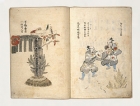Japanese Gallery (Honkan) Room 16
January 2, 2011 (Sun) - January 30, 2011 (Sun)
Calendars were created by humankind to systematize time into regular units. Ancient rulers saw governing time as synonymous with governing the land, and as a result, a variety of methods for measuring time developed in different states at different periods. The calendar most widely in use today is a solar calendar known as the Gregorian calendar, however religious calendars such as the Islamic, Jewish and Buddhist calendars still remain in use.
For 1,200 years, Japan used calendars imported from China, beginning with the Xuanming (J., Senmyo) calendar. In the early Edo period, these were replaced by the Jokyo calendar, a lunar calendar created by the Japanese calendar and astronomy scholar Shibukawa Harumi based on the Chinese Shoushi (J., Juji) calendar. The Jokyo calendar was in use in Japan until 1872 (Meiji 5), when the Gregorian calendar was adopted by order of the government.
Based on their strong relationship with the zodiac, solar and lunar orbits and other aspects of celestial movement, calendars brought regularity to people's lives and spawned related fields of scholarship, philosophy and methods of fortune-telling. This exhibition introduces important calendrical systems formerly used in Japan, in addition to specialist calendars focusing on rituals, agriculture and earthquakes, and calendars of outstanding or unusual design.

